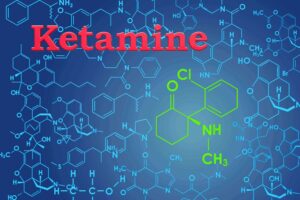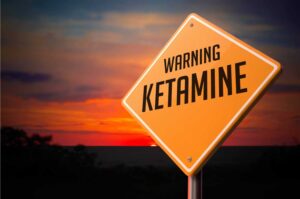Ketamine, also referred to as “Special K,” “Kit Kat,” “Vitamin K,” and “Cat Valium,” can be a confusing substance to understand. When ketamine was initially created in 1962, doctors used the drug as an anesthetic for humans and animals. Today, ketamine helps sedate people in intensive care, blocks pain for people undergoing surgery, relieves chronic pain, and eases symptoms of depression and PTSD. Unfortunately, ketamine is also commonly misused for recreational purposes. Understanding ketamine’s history, how the substance works, as well as the drug’s risks and side effects, can help you realize just how addictive ketamine can be.
What Is Ketamine Used For?
Ketamine is a medicine used to sedate people and animals. The drug produces a trance-like state that relieves pain, making it an ideal choice for situations where patients may experience extreme pain. Ketamine works so well, in fact, that the substance has been included on the World Health Organization’s “List of Essential Medicines” for a healthcare system. But ketamine is also considered a Schedule III controlled substance, meaning that, though the drug can be used medically, the substance also has the potential for addiction and physical or psychological dependence. Unfortunately, the same dissociative properties that make ketamine an excellent anesthetic are the same qualities that make the substance a popular choice for illegal drug use.
How Does Ketamine Work?
 Most of the ketamine sold and used on the streets has been diverted from veterinary offices. Most of the time, ketamine is illegally sold as a fine white powder or capsule while veterinarians typically use the liquid form. The moment you inject, smoke, snort, or consume ketamine, the drug, which has a chemical structure similar to PCP, produces an out-of-body experience, including temporary feelings of detachment from reality. Ketamine can also distort your hearing and vision, making it difficult for you to move.
Most of the ketamine sold and used on the streets has been diverted from veterinary offices. Most of the time, ketamine is illegally sold as a fine white powder or capsule while veterinarians typically use the liquid form. The moment you inject, smoke, snort, or consume ketamine, the drug, which has a chemical structure similar to PCP, produces an out-of-body experience, including temporary feelings of detachment from reality. Ketamine can also distort your hearing and vision, making it difficult for you to move.
If you consume a high enough dosage of ketamine, you can fall into the “k-hole,” a state of mind that’s so impaired you become unaware of the world around you.
The “K-Hole” Experience
Like most drugs used for recreational purposes, you can get high on ketamine, but the “k-hole” is a different experience. You can picture the “k-hole” as a state of mind that falls between intoxication and a coma. In such a state, your awareness of the real world dissipates. Changes to your senses of sight, smell, and touch can lead to illusions and hallucinations. You might even experience short-term memory loss and dissociative and psychotic symptoms that include:
- Floating sensations
- Mind and body disassociation
- Flashbacks
- Hallucinations
- Euphoria
- Confusion
Being in the “k-hole” can affect your physical body as well. Common physical symptoms associated with ketamine intoxication include:
- Trouble breathing
- Difficulty speaking
- Seizures
- Immobility and loss of coordination
- Increased heart rate
- Nausea and vomiting
- Muscle weakness
- Numbness
“It’s a really ugly thing for people to look at,” heavy ketamine user Chris explained in a National Geographic video about the substance. “But you’re personally in the total state of bliss and happiness. But when other people see you, you’re drooling on yourself and can’t stand up.”
The high usually lasts less than an hour and is followed by the ketamine comedown.
The Ketamine Comedown
The ketamine comedown is like an intense and dangerous drug-induced hangover. Coming out of the “k-hole” resembles waking up from a coma, leading most ketamine users to experience intense confusion and delirium long after the initial high ends.
After taking ketamine, you might also feel anxious, hopeless, helpless, and numb. Your muscles may become weak and your vision impaired, making it difficult to move. This inability to move combined with feelings of paranoia and anxiety can make ketamine users aggressive, irritable, and at times, violent.
Experiencing the agony of the comedown can also make you want to escape reality once again, leading to repeated use, tolerance for the substance, physical dependence on the drug, and in time, ketamine addiction.
Ketamine Addiction
Like most substances with the potential for abuse, regularly misusing ketamine can cause addiction. Ketamine addiction generally happens when people use the substance to self-medicate or to lessen the drug’s withdrawal symptoms. Both of these experiences hijack the brain’s reward system, making the brain experience:
- A desire to self-medicate. The majority of people who use ketamine recreationally do so to escape a harsh or painful reality. Behavioral health experts call this type of behavior self-medication, which is the process of using substances illegally to make yourself “feel better.” Ketamine can be especially attractive to people living with symptoms of depression. Unfortunately, the euphoria that ketamine produces doesn’t last long, and once again, users must come face to face with the truth of their reality. Wanting to continually escape their pain can lead to repeated use which can, in turn, lead to ketamine abuse and addiction.
- Intense withdrawal symptoms. After using ketamine repeatedly, your body becomes accustomed to the presence of the substance in your system. When you stop taking ketamine, step away from the drug, or try to wean yourself off the substance, you may start to experience withdrawal symptoms. Even though these symptoms can vary, some of the most common include depression, nightmares, insomnia, fatigue, anger, tremors, anxiety, and restlessness. Ketamine withdrawal can also lead to suicidal thoughts and urges. But more than anything, these symptoms can make you crave an escape from reality once more, leading you to consume a higher dose of ketamine. The more you take ketamine, the more the substance rewires your brain’s reward system.
- A change in the reward system. Addiction to ketamine can cause chemical changes in your brain’s reward system. Scientists continue to study the exact changes that ketamine causes, but once the brain’s reward system loses balance, you will have a difficult time quitting the drug. Ketamine also creates feelings of detachment, so once you’re addicted to the drug, you may choose to neglect work and family responsibilities, as well as other healthy activities and relationships in your life. As a result, you might feel like ketamine is your only source of “pleasure.”
Risks & Side Effects of Ketamine Abuse
 Combining ketamine with other substances is one of the biggest risks of using the drug. Ketamine overdose deaths aren’t common, but when the substance is used with alcohol, depressants, or other sedatives, the risk of toxicity and death increases significantly.
Combining ketamine with other substances is one of the biggest risks of using the drug. Ketamine overdose deaths aren’t common, but when the substance is used with alcohol, depressants, or other sedatives, the risk of toxicity and death increases significantly.
Sedatives and depressants slow activity in your central nervous system. Ketamine slows down your body’s organs even further, which may make it hard for you to breathe and difficult for your heart to pump oxygen throughout your body, potentially leading to death.
Abusing ketamine can also cause a number of other long-term effects on your body, which include:
- Kidney, bladder, and heart damage
- High blood pressure
- Respiratory problems
- Amnesia
- Seizures
- Psychosis
- Impaired brain functionality
Signs & Symptoms of Ketamine Use
One of the best ways to prevent ketamine addiction is by knowing the signs and symptoms that indicate ketamine use. Ketamine can affect users differently, but the substance’s intense effects on the brain and state of mind can make recognizing signs and symptoms of ketamine use fairly easy to spot. Using ketamine can yield unpredictable results, but most people experience a feeling of sedation. Unfortunately, that relaxed feeling is often paired with insomnia, tremors, paranoia, delirium, and hallucinations.
Others signs and symptoms of ketamine use can include:
- Frequent drowsiness
- Distraction
- Fatigue
- Irritability
- Antsy behavior
- Rapid eye movement
- Depression
- Lack of motivation
- Reduced ability to feel physical pain
- Problems balancing and loss of coordination
- Slurred speech
- Insomnia
- Bladder pain
- Incontinence
- Trouble breathing
- Memory problems
Holistic Outpatient Treatment for Addiction
At BlueCrest Recovery Center, our approach to addiction treatment combines evidence-based practices and principles from the 12-step program. We also incorporate spiritual therapies like mindfulness and meditation into our comprehensive program that offers cognitive and dialectical behavioral therapy.
Best of all, we’re an outpatient care facility. You can overcome your addiction challenges and rehabilitate your life while maintaining your job, continuing school, and remaining close to family and friends. Call us today at 888.292.9652 if you or a loved one are grappling with addiction challenges.


















